U-Multirank Covid-19 Radar: Implications of Covid-19 from the students’ perspective
U-Multirank
Jun 27, 2021 00:00 (CEST)
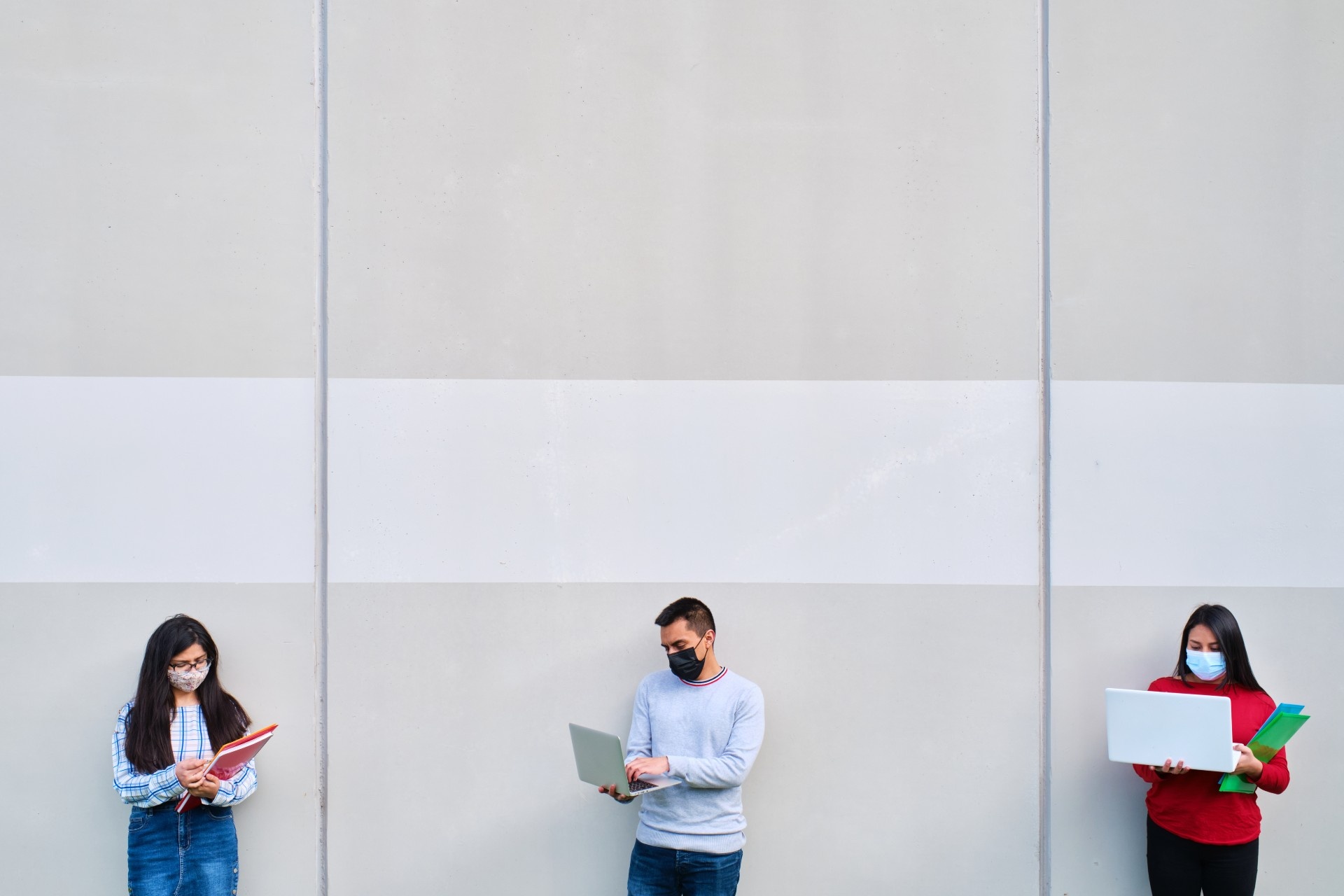
Introduction
After nearly a year and a half since the outbreak of the Covid-19 pandemic, universities are no longer what they used to be. International mobility has been affected heavily, many universities faced severe financial problems, and campuses were locked down for weeks or even months. Consequently, the relation of students to their universities changed dramatically: teaching had to be switched almost from one day to the next with presence learning shifting to digital, or blended modes of delivery. Many students who started their coursework in 2020 reported that until now they have never been on their campus, and never met their teachers personally.
As higher education is a highly self-reflexive system, studies on the impact of Covid-19 have been conducted and published. Recently the European Commission published a synopsis of the various studies drawing on 14 rapid-response surveys carried out in 2020 by university networks, student organisations and researchers, as well as over 50 journal articles, reports and publications. This synopsis looked at short- and long-term aspects as well as conclusions on different levels of action. In the first months of the pandemic their focus was on financial impacts and on the negative effects on international mobility (which is closely linked in some countries). Other studies focused on the student experience and student life, but many of their results and conclusions of the impact of Covid-19 on students (for example, on the growing incidence of depression) are not specific to higher education, but rather reflect general impacts of the pandemic on social life and on individuals.
A crucial question, so far not really addressed, is whether the recently enroling student Covid-cohorts feel that they have suffered from the restrictions and hence face future career disadvantages.
To answer this question, U-Multirank can link specific questions and data on the impact of Covid-19 and the pandemic management with its general data on institutional performance and the views of students on their learning experience. In particular, U-Multirank data allow for comparisons between the pre-pandemic situation, based on previous data collection, and the pandemic situation. Additionally, U-Multirank data also allow for distinguishments between subjects and academic fields, which is largely overlooked in existing studies.

From presence to online learning: A dramatic shift from one day to the next
Due to the outbreak of the pandemic, universities worldwide had to close their campuses for often long periods of time. From one day to the next universities had to switch from in-person classes to digital and blended classes. According to U-Multirank's institutional data, in autumn 2020, 92% of all courses were held either fully online or in a blended form, compared to only 10% before the pandemic. Universities worldwide were ready to make this digital turn within the shortest time frame.
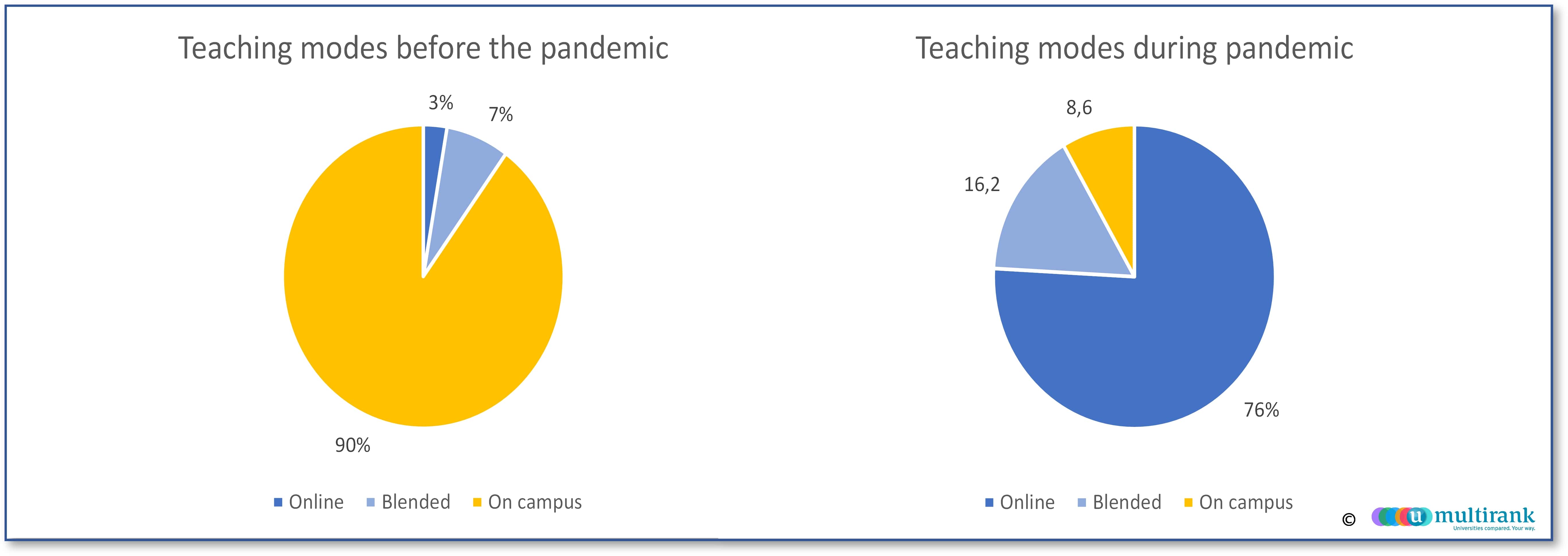
Students appreciated how universities handled the pandemic, but to a lesser extent in various subjects
Based on the most recent U-Multirank student survey, which ran from October 2020 to January 2021, around two thirds of the 30,000 respondents rated the overall pandemic management of their university either as ‘very good’ or ‘good’, while only 6% gave a negative rating (‘bad’ or ‘very bad’).
At the same time there are substantial differences between subjects. Students in the medical subjects (incl. veterinary science) were less satisfied than students of other subjects, such as psychology, social work or agriculture.
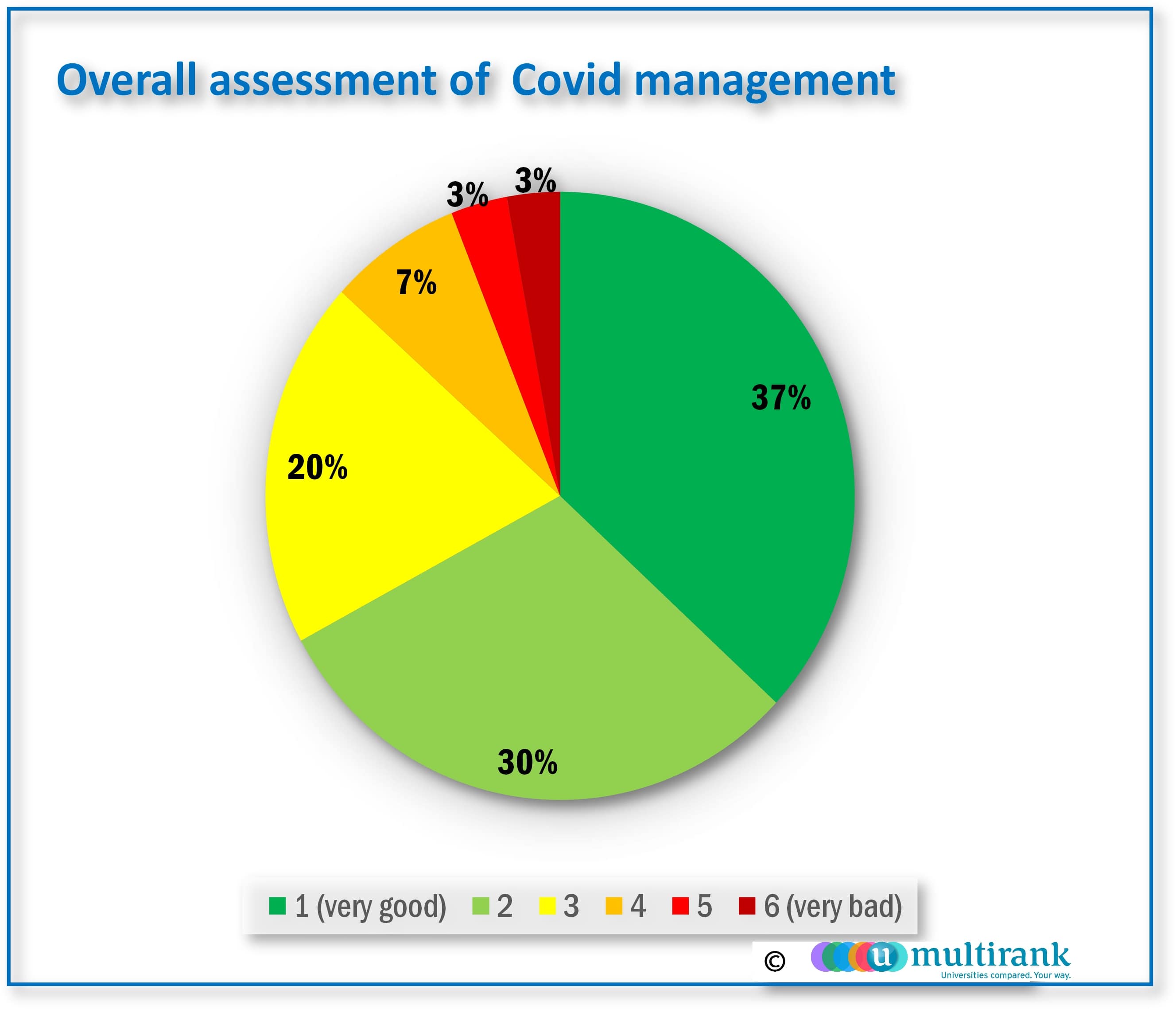
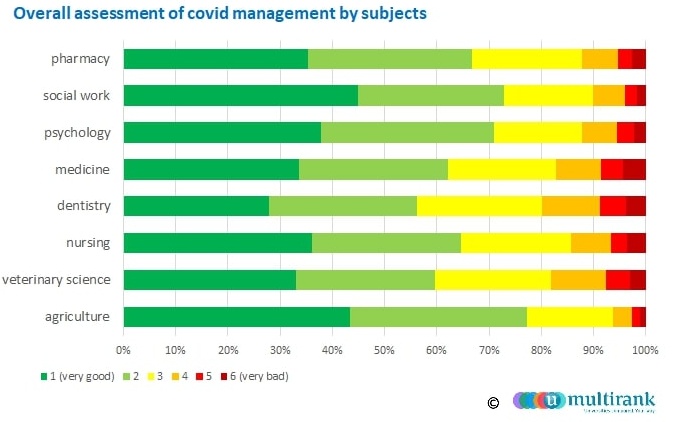
Cancellation of classes depended on the subject
Offering digital education helped many universities to sustain their classes and avoid cancellations. The various educational programmes show large differences. In social work and psychology, around 70% of the universities faced no cancellations at all and all classes took place. However, in medical fields cancellations were higher. In dentistry, nursing and medicine a substantial number of courses were cancelled - with more than half of dentistry and nursing courses alone being cancelled. In these fields, practical courses including contact to other persons (patients) are highly relevant and could not easily be digitalised.
We expect that the differences in student satisfaction with the pandemic management are linked to problems of continuing the provision of courses in these subjects.
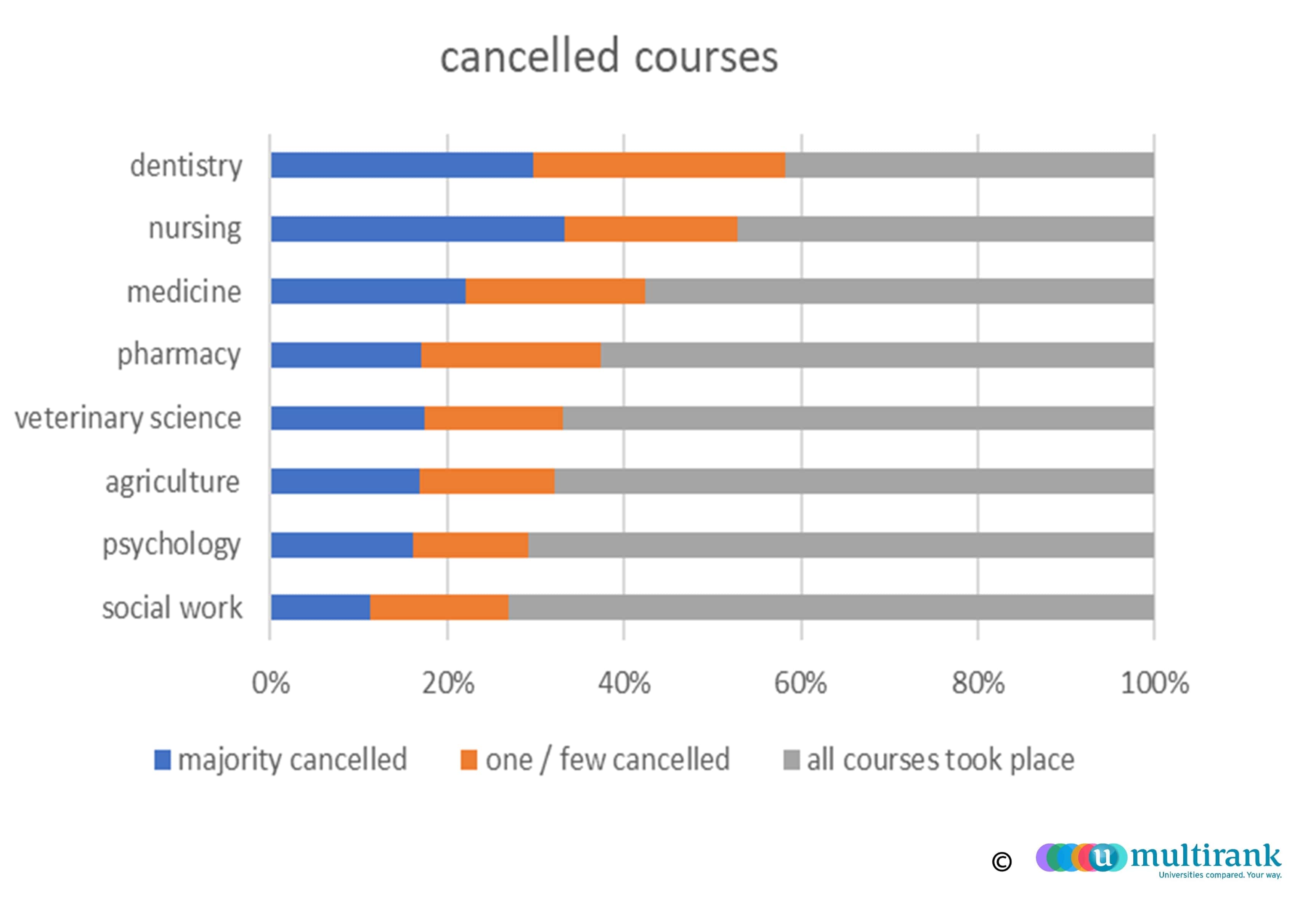
Students are optimistic about the continuation of their studies, but opinions vary by subject
All in all, a clear majority of students across all subjects are optimistic that they can continue their courses as planned after the pandemic.
However, students in the medical subjects particularly, fear more often than others that this may not be possible. In social work, psychology and agriculture almost 80% of the students rated their expectations to be able to continue as planned with ‘very good’ or ‘good’ – compared to less than 60% in dentistry, and less than 70% in medicine and nursing.
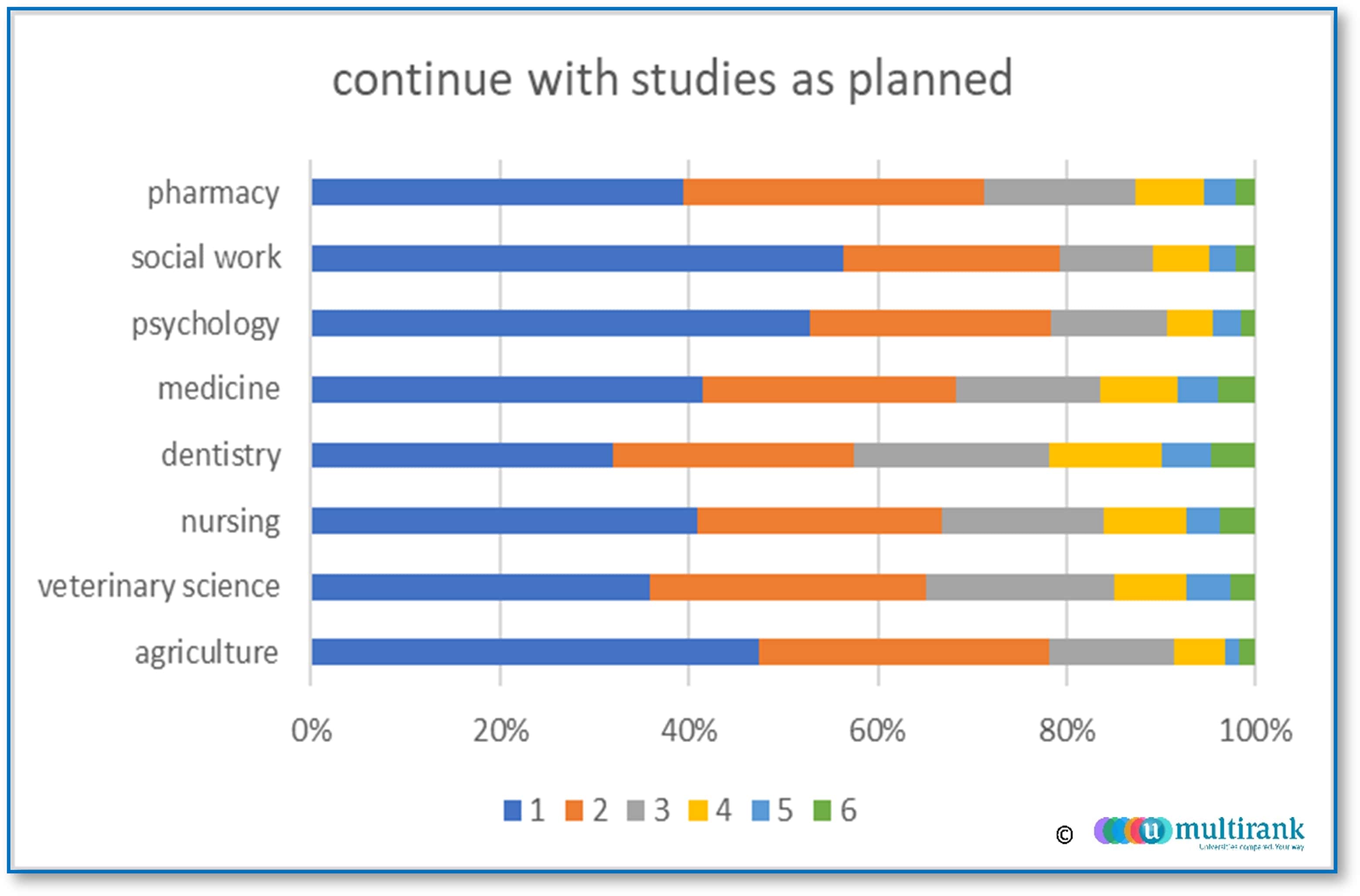
The pandemic affected the learning experience of students
The assessment of a number of aspects, including ‘IT-provision’ and ‘contact to teachers’ (and other aspects not listed in the graph as organisation of programmes) have improved from 2018 to 2021 (the graphs show the mean scores, with ‘1’ marking the positive end of the scale). However, the overall assessment of the learning situation was rated more negatively in 2021 by students of all the subjects, with the most negative scores in dentistry, medicine and nursing.
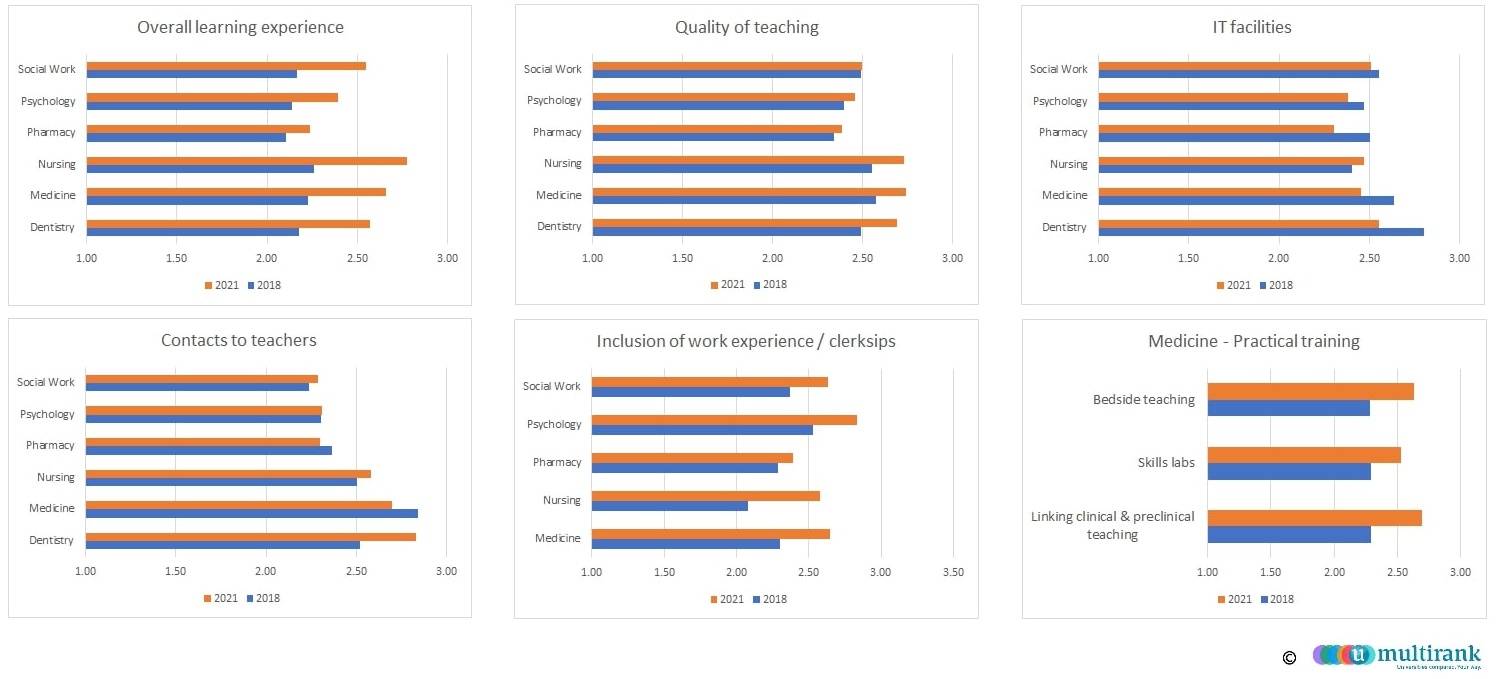
Furthermore, specific aspects that are affected by the pandemic are seen more negative by students now: all indicators related to ‘practical teaching’ and ‘inclusion of work experience’ suffered from the pandemic situation. Additionally, ‘inclusion of work experience’ is rated particularly negative in social work, nursing and medicine, where this implies direct personal contacts (to clients, patients, etc.). For medicine this is confirmed in more detail by specific indicators looking at, e.g. clinical education, bedside teaching and clerkships.
Conclusions
- The question of ‘if the universities were prepared for the pandemic?’, gives a mixed impression: on the one hand, relatively few universities had experiences with purely online courses before the pandemic started. On the other hand, they were sufficiently prepared to realise a swift digital turn and offer the large majority of courses online within a very short time.
- Most universities did not leave their students alone in the pandemic situation. They made enormous efforts to avoid cancellations of classes and keep the progress of students in their programmes going. This led to a positive student assessment of the overall handling of the pandemic situation and to a mostly optimistic view of students on the timely continuation of their studies. But still, the assessment of the overall learning experience by students is less positive than before the pandemic – across all subjects.
- For the medical fields, the situation is particularly difficult. In the health-related subjects, in which practical education and direct personal contacts to clients and patients are a major factor of the education, the students’ assessments are less positive than in the other subjects. The results of U-Multirank show that students in those subjects are more concerned about the quality of their education, particularly about the practical aspects. With their strong interpersonal focus, these are also the subjects, in which a substantial number of courses were cancelled and could not be replaced by online classes. Hence students are more pessimistic that they can continue and finish their degree as planned. The specific design of blended learning approaches needs to be customised to the needs of the respective discipline.
- The comparison of student satisfaction between 2018 and 2021 gives some indication what went well and where the deficiencies in the pandemic situation occurred. We first see that the overall learning experience worsened – this corresponds with other studies showing the desperate personal situation of many students sitting at home. However, students also indicated that IT provision and even contact to teachers had improved. The latter is a surprise and makes clear that digital teaching does not necessarily mean that students and teachers lose their connection. For some fields, this leaves the perceived quality of teaching unchanged. However, in the medical subjects, the assessment of the quality of teaching decreased, and two other findings show potential reasons, why this is the case: both the assessment of ‘inclusion of work experience’ and ‘practical teaching’ worsened substantially.
- Coming back to the question, ‘did the pandemic leave a cohort of students that fear to have a loss in qualifications?’, we’ve generated some insights. Universities and teachers engaged with students in order to keep a close connection, as well as deliver online teaching, and provide IT facilities. However, U-Multirank data show that the recent cohorts of students are confronted with some challenges: they must adapt their learning behaviour to online and blended learning, and many students have fears that they may face a delay in their graduation (particularly those in the health subjects). In general, the practical training and contacts to work environment have suffered, particularly in those subjects (health, social work) in which practical training implies close personal contacts. These aspects of teaching and learning are highly important for the quality of the courses. To a certain extent, this student generation loses a set of skills which is seen as important for their personal development. Depending on the subject, this loss is more or less relevant.
Lessons learnt
In their efforts to deal with the pandemic and to compensate for its negative effects thereafter, universities and higher education policies have to take into regard that there isn’t a one-size-fits-all approach for all subjects. In general, practical education and contacts to work environment (e.g. excursions, internships) suffered from the restrictions caused by the pandemic. Nevertheless, in many subjects (not only the social sciences and the humanities, but also the sciences and engineering) new forms of online and blended learning were helpful to deal with the pandemic and may even bring new opportunities for innovative teaching in the future. In other subjects where personal interaction and contacts are a major aspect of the education and qualification process – medicine, dentistry, nursing – the replacement of (practical) teaching by online formats is more difficult or has so far proven to be impossible. This is indicated by the high percentage of courses that were cancelled in these subjects.

After the pandemic, these courses will by large be possible again. But the most recent cohort of students (entrants in spring 2020 already spent more than a full academic year, respectively three semesters under Covid-19 restrictions) - particularly those in the health subjects mentioned - fear that it will become difficult to graduate in a ‘normal’ way and with the ‘regular’ set of qualifications and skills. Here universities are challenged to introduce specific means and programmes to compensate for these negative effects of teaching and learning under the pandemic.

MICHAEL MURPHY, PRESIDENT OF THE EUROPEAN UNIVERSITY ASSOCIATION (EUA)
“A key message of the U-Multirank analysis is that in designing the ‘new normal’ post pandemic, we must concentrate efforts and resources particularly on those disciplines that have more catching up to do and to devise novel ways to deliver virtual teaching and learning experiences in them. Otherwise, we are doomed to repeat this experience when the next pandemic inevitably arrives.”
U-Multirank - Basic information
U-Multirank is a non-commercial, global, multi-dimensional transparency tool, combing institutional rankings of entire universities with a set of 28 subjects rankings. Each ranking presents more than 30 performance indicators, covering five dimensions: teaching & learning, research. Knowledge transfer, international orientation and regional engagement.
The major aim of U-Multirank is to make diversity of higher education visible – hence it includes a diverse set of higher education institutions with different missions and different profiles. Our unique interactive web tool allows for comparisons among institutions with similar profiles.
All results and data are freely accessible under: www.umultirank.org
U-Multirank is a multi-perspective ranking, combining data from different data sources: data from national statistics, data from bibliometric and patent data bases, institutional and subject related data provided by institutions and a student survey based on responses from 100,000 students.
U-Multirank’s 2021 edition will be published online in September and will include more than 2,000 higher education institutions from nearly 100 countries worldwide.
Contact: info@umultirank.org




